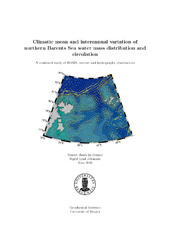| dc.description.abstract | Evaluating current measurements, hydrography observations and model (ROMS) results of the northern Barents Sea, water mass distribution and circulation is investigated. Water mass exchange with the Arctic Ocean is linked with interannual variation of the Svalbard branch. The validity of ROMS in the study region is discussed. ROMS give typically barotropic and topographically steered currents, flowing in narrow bands approximately 10-50 km wide. Current directions differ highly from previous interpretations of the flow from hydrographical observations, yet they are consistent with current meter observations in the region. Model validation indicate ROMS water masses are too saline, however the vertical salinity distribution is close to the observed, and that temperatures are too high especially for Surface and Arctic Water. It is evident Atlantic Water in the Svalbard branch descents under Arctic Water too far east in the model, biasing the inflow towards too much Atlantic Water high up in the water column. Atlantic Water intrudes the region from north as parts of the Svalbard branch follow topography into the troughs of the Northern Barents Sea Opening (NBSO), the Franz Victoria Trough and Kvitøya Strait. Estimates of model transports show the interannual variation of mass transport in the Svalbard branch could explain nearly 50% of the interannual variation of mass inflow through the NBSO with a time lag of one year. The estimates also show interannual variation of heat transport in the Svalbard branch could explain 37% of the interannual variation of heat transport into the northern Barents Sea through the NBSO. After entering the northern Barents Sea, Atlantic Water follows topography and gradually loosing its heat content primarily from mixing with Arctic Water. Model results and observations support water mass modifications from brine enrichment during sea ice formation and cooling of Arctic and Surface Water on Storbanken produce Cold Halocline Water. The model gave Cold Bottom Water in its depressions and a bottom-intensified cold current in the Franz Victoria Trough. These flows add up to a net mass and heat transport of 0.33 Sv and 7.6 TW into the Barents Sea through the NBSO, where the Franz Victoria Trough dominate the heat transport and the Kvitøya Strait dominate the mass transport. The largest contribution to the net heat transport is due to warm water inflow in Franz Victoria Trough. | en_US |
